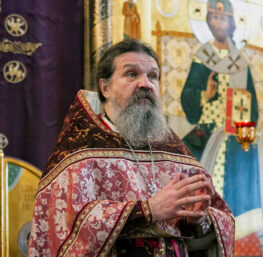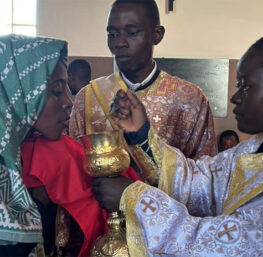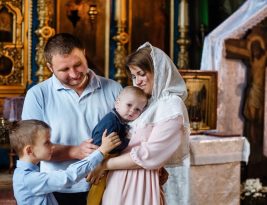January 2, 2005
In the Christian East it is the Baptism of our Lord that receives the dominant emphasis in the Church’s annual celebration of Theophany (commonly called Epiphany in the West) on January 6. This feast is celebrated, moreover, as the manifestation of God as Father, Son, and Holy Spirit.
This emphasis is clear in the troparion of the day: “When Thou, O Lord, wast baptized in the Jordan, the worship of the Trinity was made manifest; for the voice of the Father bore witness to Thee, calling Thee His beloved Son; and the Spirit, in the form of a dove, confirmed the truth of His word. Wherefore, O Christ, who didst appear and enlighten the world, glory to Thee.”
The dogma of the Holy Trinity pertains to theology in the strict sense. It is not part of the Church’s proclamation to the world. On the contrary, it is a mystery shared only within the Body of the Church. Indeed, it is revealed to the believer in the very act by which he joins the Church, the initiatory mystery of Baptism.
This is suggested in the Gospel itself, where the Trinitarian revelation at our Lord’s Baptism at the beginning of His ministry (Matthew 3:16-17) is paralleled at the close of it by a corresponding command to baptize all nations “in the name of the Father, and of the Son, and of the Holy Spirit” (28:19). The Church, said Origen in the third century, is “full of the Holy Trinity.”
The dogma of the Holy Trinity affirms that God has revealed to the human race His eternal inner life in two missions, two “sendings forth”: “But when the fullness of time had come, God sent forth his Son . . . God sent forth the Spirit of his Son . . . ” (Galatians 3:4-6). That is to say, the Father revealed himself in His Son as a visible Man in the external, categorical, documentable order of human history, and likewise He has revealed Himself by the Holy Spirit in the internal, transcendent order of transformed human consciousness. This is the revelation that the Church celebrates in the feast of the Theophany.
Both aspects of this revelation of the Father are essential to the being of the Church: (1) the horizontal, linear link by which, unto the end of time, we are joined back to the historical Christ (“you proclaim the Lord’s death till he comes”), and (2) the vertical, transcendent axis by which we are joined at all times to the God who reigns above us and in our hearts (“and behold, I am with you all days”). The cruciform conjunction of these two revelatory lines, the horizontal and the vertical, is the point where Christians live and worship.
The first of these dimensions is anamnetic; it is handed on and carried forward in historical memory (“Do this in remembrance of me”). It is Christological and Paschal. The second is epikletic and transcendent to the limitations of history (“Oh that you would rend the heavens! That you would come down!”). It is Pneumatological and Pentecostal.
There are not two different “economies” of the Son and the Holy Spirit. Both pertain to the single economy of redemption. Both the Son and the Holy Spirit are necessary to our return to the Father. They are, in the words of Irenaeus of Lyons, God’s two hands at work in this world.
In addition to His Baptism, other places in the life and ministry of Christ our Lord also provided special settings for the revelation of the Holy Trinity. Indeed, the Incarnation itself was such a setting, when God the Father sent the Holy Spirit to overshadow the Virgin Mary so that she conceived his Son in her womb (Luke 1:35). Likewise, this overshadowing Spirit descended on Jesus at his Transfiguration, while the Father’s voice once again identified his Son (Luke 9:34f). The same Trinitarian revelation took place in the Resurrection, when the Father raised his Son by the power of the Holy Spirit (Romans 8:11; cf. 1:4).
And just as we are reborn in the Trinitarian name, many biographies of Christians portray them invoking the Holy Trinity in the hour of their death. By way of example I may cite a memorable instance, which occurred on the evening of May 25, 735, when the earliest historian of the English people, Saint Bede the Venerable, went to God just after Vespers of the Feast of the Ascension. A description of his death was left us by his contemporary and fellow teacher, Cuthwin: “And thus, on the floor of his cell, he chanted ‘Glory to the Father, and to the Son, and to the Holy Spirit’ to its ending, and breathed his last.”



